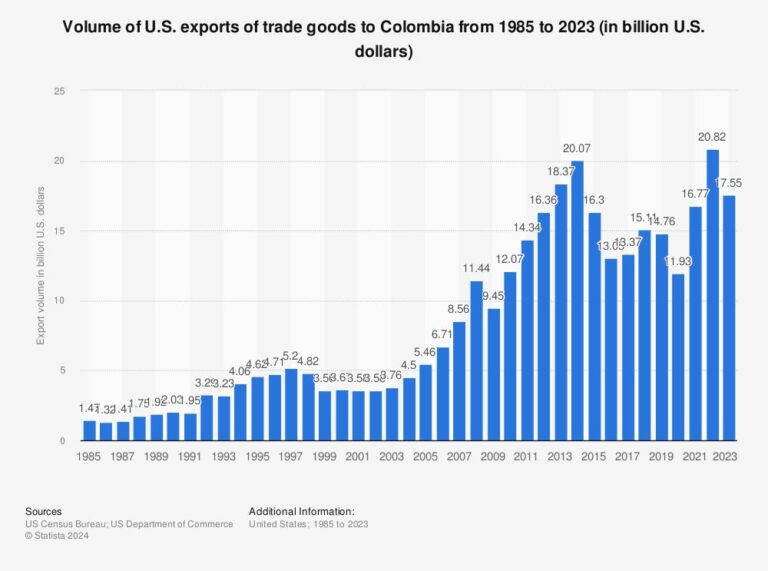Trade between the United States and Colombia continues to be a cornerstone of American export strategy in Latin America, even as China deepens its economic footprint across the region. According to a recent report by the Atlantic Council, US exporters are capitalizing on Colombia’s strategic position and robust market demand, reinforcing longstanding commercial ties. This dynamic unfolds amid an intensifying competition for influence in Latin America, where China’s growing investments and trade partnerships are reshaping regional economics and geopolitics. The evolving landscape presents both opportunities and challenges for US businesses seeking to maintain and expand their presence in Colombia and beyond.
Trade with Colombia Drives Significant Growth for US Exporters
US exporters have found a robust market in Colombia, where demand for American goods is steadily rising despite increasing competition from Chinese investments throughout Latin America. Key sectors driving growth include agricultural products, machinery, and technology, bolstering bilateral trade figures substantially over recent years. With Colombia’s strategic location and expanding economy, US businesses are leveraging this partnership to diversify their export portfolios and reach new customer bases.
Several factors contribute to this success:
- Favorable trade agreements ensuring reduced tariffs and streamlined customs processes
- Growing middle class in Colombia with enhanced spending power
- US government initiatives supporting export readiness and market access
| Export Sector | Annual Growth (%) | Top US Export Commodity |
|---|---|---|
| Agriculture | 12 | Soybeans |
| Machinery | 9 | Construction Equipment |
| Technology | 14 | Semiconductors |
Chinese Investment Expands Rapidly Across Latin America Challenging US Market Share
In recent years, Chinese capital has surged through Latin America, carving out new economic pathways and posing a direct challenge to the longstanding dominance of U.S. exporters. This expansion is particularly notable in sectors such as infrastructure, mining, and energy, where Chinese investments, backed by state-led financing, have enabled large-scale projects that rival traditional U.S.-led initiatives. These ventures not only boost local economies but also reshape regional trade dynamics, compelling American businesses to reassess their strategies amid intensifying competition.
Several factors contribute to China’s successful penetration of the Latin American market, including:
- Flexible financing options that often come with fewer political conditions compared to Western counterparts.
- Comprehensive trade agreements that broaden the scope for Chinese exports and imports.
- Strategic partnerships fostering technological exchange and infrastructure development.
As these initiatives deepen, the U.S. faces growing pressure to foster innovation and reinforce trade ties in Colombia and across the region to maintain its competitive edge.
| Investment Source | Sector Focus | 2023 Investment (USD Billions) |
|---|---|---|
| China | Energy & Infrastructure | 12.4 |
| USA | Manufacturing & Agriculture | 9.1 |
| European Union | Technology & Services | 4.7 |
Strategic Opportunities for US Businesses to Strengthen Ties in Colombia
US companies are uniquely positioned to capitalize on Colombia’s expanding market, driven by robust economic reforms and a young, dynamic workforce. Key sectors ripe for collaboration include technology, renewable energy, and infrastructure development. By fostering joint ventures and leveraging Colombia’s strategic location as a gateway to Latin America, American exporters can deepen engagement while building resilient supply chains. Crucially, aligning business strategies with Colombia’s governmental priorities, such as sustainable development and digital modernization, enhances long-term prospects for market penetration and partnership growth.
Opportunities at a glance:
- Investment in green energy projects—solar and wind farms gaining momentum
- Advanced manufacturing and technology transfer to boost local innovation
- Infrastructure upgrades across transport and logistics networks
- Trade facilitation supported by US-Colombia Free Trade Agreement provisions
| Sector | US Export Potential | Colombian Growth Drivers |
|---|---|---|
| Renewable Energy | $500M+ | Government incentives, climate policies |
| Technology & Innovation | $250M | Digitalization push, startup ecosystem |
| Infrastructure | $400M | Transport modernization, urbanization |
Policy Recommendations to Counterbalance Chinese Influence in the Region
To effectively address the expanding Chinese footprint in Latin America, especially Colombia, U.S. policymakers must prioritize targeted strategies that enhance regional economic resilience and deepen diplomatic ties. Strengthening trade agreements that emphasize reciprocal market access and fair investment practices will be essential. Additionally, increased funding for infrastructure projects spearheaded by American companies can counterbalance China’s Belt and Road Initiative ventures, fostering sustainable development aligned with U.S. economic standards and regional priorities.
Moreover, the U.S. should intensify collaboration on technological innovation and workforce development, ensuring local industries remain competitive amid growing Chinese competition. Bolstering educational exchanges and capacity-building programs can cultivate a regional leadership attuned to democratic governance and free-market principles. The table below outlines potential policy actions and their strategic benefits:
| Policy Action | Strategic Benefit |
|---|---|
| Expand Trade Facilitation | Improves market access, boosts U.S. exports |
| Infrastructure Investment | Counters Chinese financing, promotes sustainable growth |
| Technology Partnerships | Enhances innovation, preserves regional competitiveness |
| Educational Programs | Strengthens leadership, supports democratic values |
In Retrospect
As China continues to deepen its economic ties across Latin America, Colombia remains a critical battleground for influence in the region. For U.S. exporters, the stakes are high, with trade relations serving as both an opportunity and a strategic challenge. Navigating this complex landscape will require sustained engagement and adaptive policies to ensure that American businesses can capitalize on Colombia’s growth while countering the expanding presence of Chinese competitors. The evolving dynamics of U.S.-Colombia trade underscore the broader contest for economic leadership in Latin America, making it a key focus for policymakers and industry leaders alike.




